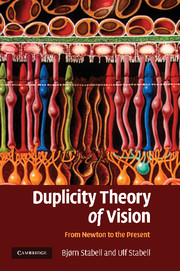Book contents
- Frontmatter
- Contents
- Acknowledgements
- 1 Introduction
- Part I The development of the basic ideas of the duplicity theory from Newton to G. E. Müller
- 2 The Newton tradition
- 3 The Schultze tradition
- 4 The Goethe tradition: the phenomenological approach
- 5 The colour theories of Armin Tschermak and George Elias Müller
- Part II The development of the duplicity theory from 1930–1966
- Part III Chromatic rod vision: a historical account
- Part IV Theories of sensitivity regulation of the rod and cone systems: a historical account
- Part V Factors that triggered the paradigm shifts in the development of the duplicity theory
- References
- Index
5 - The colour theories of Armin Tschermak and George Elias Müller
Published online by Cambridge University Press: 22 January 2010
- Frontmatter
- Contents
- Acknowledgements
- 1 Introduction
- Part I The development of the basic ideas of the duplicity theory from Newton to G. E. Müller
- 2 The Newton tradition
- 3 The Schultze tradition
- 4 The Goethe tradition: the phenomenological approach
- 5 The colour theories of Armin Tschermak and George Elias Müller
- Part II The development of the duplicity theory from 1930–1966
- Part III Chromatic rod vision: a historical account
- Part IV Theories of sensitivity regulation of the rod and cone systems: a historical account
- Part V Factors that triggered the paradigm shifts in the development of the duplicity theory
- References
- Index
Summary
THE COLOUR THEORY OF TSCHERMAK
In developing his own colour theory, Tschermak (1902, 1929) made a critical evaluation of the colour theories of Young-Helmholtz, Schultze and Hering. With regard to Young-Helmholtz's colour theory, he was severely critical. Thus, he asserted that the basic assumption of three independent, primary colour-related processes postulated by the trichromatic theory could not be reconciled with the phenomenological analysis of colour sensation that revealed six qualitatively different unitary sensations: red, yellow, green, blue, white and black. It would, for example, be impossible to give an adequate explanation of the uncompounded yellow-related material process by green- and red-related processes, or the uncompounded white-related process by red-, green- and violet-related processes. Also, in opposition to the trichromatic colour theory, experiments on colour mixture, colour induction and colour contrast clearly revealed opponent interaction processes going on in the visual system.
Finally, in accord with von Kries (1911), Tschermak (1902, 1929) pointed out that the basic assumption of the trichromatic colour theory, that white sensation was generated when the three different types of cone receptors were activated to about the same degree, was seriously challenged by the fact that colourless sensation could also be observed in scotopic vision where only rod receptors were known to function.
With regard to Schultze's duplicity theory, on the other hand, he found the evidence strongly in favour of its basic assumptions that cones functioned in day vision giving rise to both achromatic and chromatic sensations, and that rods functioned in night vision, giving rise toachromatic sensation only.
Information
- Type
- Chapter
- Information
- Duplicity Theory of VisionFrom Newton to the Present, pp. 52 - 60Publisher: Cambridge University PressPrint publication year: 2009
